HEAVY-DUTY BENCH LATHE SYSTEMS
Rugged yet precise Automated Lathe Solutions
Like the Precision Benchtop Lathes, the Heavy-Duty Bench Lathes are purpose built to be a compact self-contained unit to minimize the overall footprint without limiting function or capabilities. They feature precision rotary motion with enough weight capacity to tackle a wide range of applications. Synchronized driven tailstocks are an option that can provide additional control and accuracy as well as minimizes or eliminates the need for pre-tacking parts. AMET builds the Heavy-Duty Bench Lathes for circ seam welding in several industries including aerospace, mining/drilling, nuclear, and defense industries.
Coupled with our advanced weld controls, the lathes are highly customizable and versatile. They are configurable for circ seam welding, OD cladding, and even longitudinal welding using PAW, GTAW, GMAW, and Variable Polarity welding processes.
30+ Years of welding Automation Excellence
The Heavy-Duty Bench Lathes are purpose built to provide automated circumferential welding in a precise package. The lathes have the following capacities and capabilities:
- Part Length: Maximum part lengths range from 24 to 60 in (610 to 1524 mm) depending upon the model selected.
- Part Diameter: The maximum part diameter (OD) that can fit within the workspace is 20 in (508 mm).
- Part Clamping: The headstock is equipped with a manual chuck with a 6 in (152 mm) outer diameter clamping capacity.
- Part Weight: Maximum weight capacity of 750 lb (113 kg) when headstock and tailstock are both being used
- Headstock Rotation: Driven by a servo motor with encoder feedback, backlash is a maximum of 5 arc minutes.
- Headstock Speed: Capable of 0 to 20 RPM.
- Torch Lift: Precision motorized slide with 5.9 in (150 mm) of vertical adjustment.
- Torch Tilt: Manual torch tilting of +/- 45 degrees to provide fillet welding capability.
- Centerline Adjustment: Manual slide with up to 5.9 in (150 mm) of In/Out (Y-Axis) motion for positioning the torch over the centerline of the part.
- Tailstock Motion: Manually adjustable along the length of the rails (X-Axis) with a hand brake to lock the tailstock into position.
- Tailstock Extension: Pneumatically controlled with up to 3 in (76 mm) of motion.
Additional features are available to increase the capabilities of this Bench lathe. Please see the Optional Features section for more information.
The Heavy-Duty Bench Lathe offers the following benefits over manual welding or non-automated welding systems:
- The precision rotation of the headstock and motorized torch lift provides controllable motion for performing single or multi-pass circumferential welds without additional setup or stopping in between passes.
- The torch tower is servo motor driven which allows for programmable location. This is essential for performing multiple welds on the same part with only one weld program. This increases productivity because a separate program does not have to be loaded for each weld, and the torch does not have to be manually repositioned for each weld.
- The lathe is designed to be compact and self-contained. A workstation is included for mounting the headstock and tailstock, which also includes an equipment platform for the welding power supply and electronic components. This makes the system more organized while also minimizing trip hazards.
- Once a program is created, it is repeated by simply pressing the Start button on the Controller until a new program is loaded. This increases throughput for large volume part runs.
- These lathes are versatile. They can be used for a range of applications such as:
- Circumferentially welding end caps
- Cladding the outside of a part
- Welding additional components to the outside of parts such as stiffener rings
- Longitudinal welds
XM® Controller
The XM® Controller integrates into all of the major programmable components of the lathe. The following axes of motion and components are integrated into the system:
- Headstock Rotation: The Rotary Module integrates with the servo motor driven headstock to provide programmable motion with override capabilities. The rotation can be programmed by degrees, RPM, or time. Continuous and jogging rotation are also available through the control panel on the XM®.
- Torch Tower: The Linear Motion Module integrates with the servo motor driven torch tower to provide programmable horizontal motion (X-Axis) with override capabilities. The motion can be programmed by distance (absolute or incremental) or time and includes jogging capability. This axis also includes mechanical oscillation to increase weld joint profile and cap-pass capabilities.
- Welding Power Supply: The power supply is integrated with the XM® via a module for programming and controlling the current or voltage.
- Gas Control: Manual flow meters and a gas solenoid provide a constant gas flow rate. A soft button activates gas at the default flow rate until the button is deactivated or until the end of the weld program.
- Wire Feeder: AMET’s precision wire feed assembly and wire feed module offer control over wire speed and wire retract.
Pneumatic Control:
- Tailstock Clamping: Clamping force adjustable with a stroke up to 3 in (76 mm)
Manual Control:
- Tailstock Motion: The tailstock is manually adjustable along the length of the track and includes manual brakes.
- Centerline Adjustment: A manual slide with a manual brake is included to provide centerline adjustment of the weld head.
Testimonials
Great Partner
"AMET has been a great partner because they are appropriately positioned to act when we need a new solution engineered or need to service an existing solution. In the end the price of a solution is negligible if it works properly, and the vendor can keep it working through their service efforts. AMET knows these things and services their customers accordingly."
- Matrix Drilling Products
15+ Years
"For over 15 years now I have had the privilege of working with AMET. I have personally seen how AMET Inc. industry knowledge and engineering expertise has enabled my business to increase weld quality and production and allow our clients to improve the strength and durability of their products."
- G. Wright's Welding Ltd.
Exceptional Team
"AMET’s team is exceptional to work with. They look at the provided solution as a whole – from operator interfaces to engineering requirements, they seek to understand the customer’s needs throughout the project. This results in a welding system that is robust, embraced by the workforce, and meets the rigorous requirements of Blue Origin’s vehicles and engines. We’re excited to work with AMET on our vision of millions of people living and working in space."
- Blue Origin

1. The precision headstock provides programmable and controllable rotation for part welding. The headstock features a manual 3-jaw chuck for holding the OD of parts up to 6 in (152 mm). The speed is controllable from 0 to 20 RPM.
2. A pneumatic slide is included for horizontal motion of the torch. When activated, the slide quickly moves the torch towards and away from the centerline of the lathe. This motion can be programmed into the weld schedule to facilitate part loading and unloading, or controlled manually.
3. The vertical torch motion is provided by a precision motorized slide. The vertical motion is programmable for torch retraction after the weld to aid in part loading and unloading, and height adjustments for multi-pass welds.
4. The tailstock features pneumatic clamping to help hold the two pieces of the part in place during welding. The clamping is performed by a pneumatic cylinder that extends the tailstock horizontally towards the headstock to apply pressure to the two halves of the part being welded. The tailstock includes a faceplate with four tooling slots to provide mounting for tooling such as manual chucks or specialized fixtures.
5. Precision rails are included for both the tailstock and torch tower motion to ensure smooth and accurate positioning along the length of the lathe. These axes also include cable carriers to protect and organize the hoses and cables of the system.
6. The lathe includes a workstation that provides a mounting location for the lathe assembly as well as the weld equipment. The welding power supply and other equipment are mounted beneath the workstation tabletop to provide a complete system that can easily be moved with a forklift. Only 1 pneumatic hose, 1 gas line, and 1 power circuit are required for this system to operate.
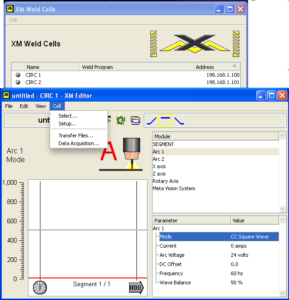 OFFLINE PROGRAMMING SOFTWARE
OFFLINE PROGRAMMING SOFTWARE
Weld programs can be created, modified, or stored on a PC. These programs can be moved back and forth between the controller and the PC using a USB storage device or through an Ethernet connection. This software can increase productivity by allowing programs to be created/edited while the weld controller is executing another weld program
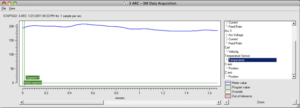 DATA ACQUISITION AND TOLERANCE CHECKING SOFTWARE
DATA ACQUISITION AND TOLERANCE CHECKING SOFTWARE
Data is collected and analyzed in real-time to ensure all modules are within the set tolerances. The data points can be displayed graphically on the display and can also be exported as a .csv file and viewed on a program such as Microsoft Excel. These files can be exported through one of the USB or Ethernet ports on the XM® or XPro Controller.
 MULTIPLE PROCESS WELD HEAD
MULTIPLE PROCESS WELD HEAD
Our advanced controls allow us to integrate multiple weld processes into one weld head. Each process can be operated independently or simultaneously. For example, a TIG & Plasma weld head would feature two AVC axes (one for each torch) and either torch could operate or they can both operate simultaneously for Keyhole Plasma with a TIG trail. We offer TIG & Plasma, TIG & MIG, TIG MIG & Plasma, and SAW & MIG. Any of these combinations are available and would be completely programmable from ONE central controller. Other combinations are also available. Please contact us with any requests.
 MAGNETIC OSCILLATION
MAGNETIC OSCILLATION
Magnetic probe is used to deflect the arc back and forth in a stirring motion for excellent sidewall tie in. The arc can also be deflected and maintained in a set position. This can be beneficial for fillet or otherwise hard-to-reach joints. Dwell time, oscillation frequency, and width are all programmable from AMET® controls. Compatible with both magnetic and non-magnetic materials.
 WELD SCREENS
WELD SCREENS
Weld screens can be added to the perimeter of the workstation to help prevent exposure to the arc by other operators or workers on the factory floor.
 AVC FOR GTAW/PAW SYSTEM
AVC FOR GTAW/PAW SYSTEM
An AVC (Arc Voltage Control) Module is added to provide the weld head with automatic arc standoff. The module provides automatic height adjustments to maintain a consistent arc voltage throughout the entire weld, including automatic adjustments on multi-pass welds.
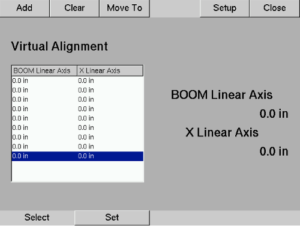 VIRTUAL ALIGNMENT (TEACHING MODE)
VIRTUAL ALIGNMENT (TEACHING MODE)
The operator can “teach” a weld path by manually moving the weld torch along the seam and selecting points. Up to 20 points can be selected to create a circumferential, longitudinal, or combination weld path. After all of the desired points are selected, the system will retrace each one to create a custom weld path. This can be helpful if parts or materials vary or have unique joint configurations. The path can be repeated for multiple pass welds, or offsets can be applied to repeat the motions of the original path in a new location.
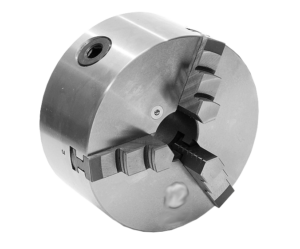 MANUAL CHUCK FOR TAILSTOCK
MANUAL CHUCK FOR TAILSTOCK
A manual chuck and an adapter plate are added to the tailstock faceplate to provide manual part gripping/holding on both ends of the lathe. The tailstock would still be equipped with the same amount of longitudinal clamping capacity.
SYNCHRONIZED HEADSTOCK AND TAILSTOCK
This feature adds synchronized rotation between the headstock and the tailstock, so rotation begins simultaneously and then continues at the same speed. The advantage of this feature is that AMET® does not link them mechanically, but electronically. Each one is servo motor controlled with encoder feedback, so they can be clocked to different positions. This is beneficial if one end of the part is required to be welded at a 90 (or any other) degree offset of the other end.
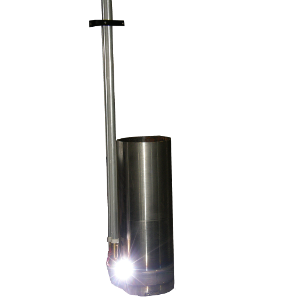 SPIRAL PATH AND STEP-INDEX CLADDING
SPIRAL PATH AND STEP-INDEX CLADDING
The vertical or horizontal axis is integrated with the rotary axis to provide precise cladding motion. We offer both Spiral Path, and Step-Index cladding options. Spiral welds begin at the bottom of the part and spiral upward until the defined height is reached. Step-Index clads in a straight line for each revolution of the part. After each revolution is completed, the torch steps upward and begins the next pass. The pitch of the spiral and the step height are programmable.
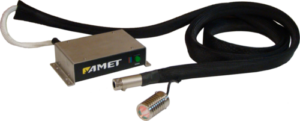 ARC VIEWING CAMERA
ARC VIEWING CAMERA
Arc Viewing Cameras can be added to a GTAW/PAW system giving the operator a view of the weld arc from a remote location. This keeps the operator in a safe location and reduces operator stress and fatigue. Additionally, the image that is shown on the monitor is magnified and shows greater detail than what could be observed without the camera. Multiple cameras may be integrated for projects where a view of the lead and trail side of the weld zone is required. Please see the Arc Viewing Camera page for additional information.
 PLC CONTROLS
PLC CONTROLS
We integrate components into our controls for automating additional functions other than the welding process. These components include safety equipment such as automatic weld screens or curtains that are programmable to automatically open and close at the end or beginning of each weld. We can also integrate additional tooling such as automated part loading equipment.
 MECHANICAL OSCILLATION
MECHANICAL OSCILLATION
A precision servo motor driven ball screw slide with encoder feedback provides mechanical oscillation. The oscillation motion is completely programmable including dwell time, oscillation frequency and width, and travel speed.
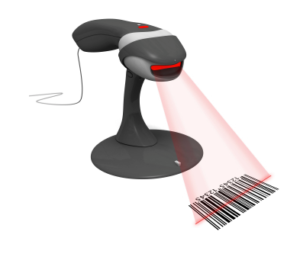 BAR CODE PROGRAM SELECTION
BAR CODE PROGRAM SELECTION
Weld programs can be automatically selected by scanning a bar code associated with a specific part. This can help eliminate the incorrect program being loaded and run. Beneficial if many different parts are to be welded and operator needs to frequently switch between weld programs. Includes the bar code scanner and the necessary software to integrate with the XM® or XPro Controller.
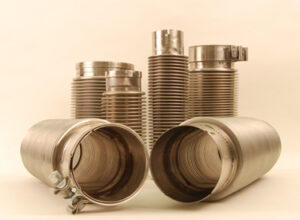 STEEL HOSE MANUFACTURING
STEEL HOSE MANUFACTURING
AMET has helped clients automate their welding processes for steel hose manufacturing. Seam welding is an efficient way of producing custom tubing from thin wall steel and stainless steel for use in a wide range of industrial and exhaust applications. Once welded, the tube may be outfitted with specialized end fittings or hydroformed into corrugated tube for flexible connections.
 PIPE FITTINGS
PIPE FITTINGS
AMET’s automated welding systems offer several options for welding pipe fittings such as tees, elbows, and flanges with butt or socket joint configurations.
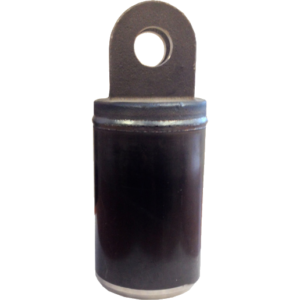 HYDRAULIC CYLINDERS
HYDRAULIC CYLINDERS
Circ seam welding is necessary to join the cylinder and the end cap fixture. AMET’s lathes are ideal for welding hydraulic components like these because they can be set up to accommodate a wide range of weld processes and cylinder sizes.
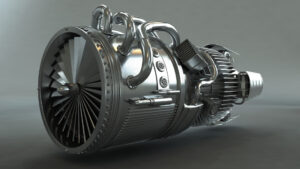 ENGINE COMPONENTS
ENGINE COMPONENTS
Precision engine components for the aerospace industry have tight tolerances and strict quality control. Precision motion and repeatability are essential when manufacturing these components. AMET’s servo controlled axes of motion are well-suited to meet such stringent requirements.
 AIR CYLINDERS
AIR CYLINDERS
Cylinders used for pressurized air storage such as air compressors, portable air tanks, and truck brakes. Manufacturing of these cylinders requires longitudinal and circumferential welds.
 PIPE CLADDING
PIPE CLADDING
ID and OD pipe cladding are available on our systems. We offer spiral and step-index cladding to fulfill the needs of most applications.
Useful Links and Information:
Links
Contact
Please call, write, or email our headquarters in Rexburg, Idaho for more information on how we can better serve you.
355 Dividend Dr
Rexburg, ID 83440

